Here are the great bike links from around the world that caught our eyes this week:
Bikes as weapons: A 1901 magazine article about how to use your bicycle as a weapon against criminals spent the first 113 years of its life waiting for its illustrations to be turned into animated GIFs.
The Tokyo model: Tokyo has just 7 miles of bike lanes but a 16 percent mode share and almost everyone uses a bike. How on Earth do they do it?
Cash for commuting: France is experimenting with paying people to bike to work — 54 cents a mile.
A helmet truce? If any person alive could “end the helmet wars,” it’d probably be Bicycle Quarterly’s Jan Heine. His latest essay probably won’t succeed, but might deserve to.
Privilege and biking: Barb Chamberlain of Spokane makes a usefully comprehensive list of all the privileges that helped her start bike-commuting — none of which had to do with infrastructure.
MADD against driving: CityLab’s Somer Mathis points out how odd it is that the hugely effective group Mothers Against Drunk Driving has never advocated for public transit or ride-hailing services.
DC dreams big: Washington DC’s new transportation plan calls for a 72-mile network of protected bike lanes, an anti-congestion charge on downtown cars and much more.
Mandatory high-viz? A lawyer who specializes in helping people avoid penalties from auto collisions says people should be required to wear high-visibility clothing while walking at night.
Digital high-viz: A $50,000 contest is looking for ways to use networked smartphones to “keep pedestrians safe and alert.”
Advertisement
Safe Citi: One year after a Rutgers professor predicted that with Citi Bike, NYC fatalities would triple, nobody has died on a Citi Bike at all. Of 8.75 million trips, only 25 have ended in the ER.
Bike share annoyances: A funny video reminds us that bike share hardware is still sorta hard to use.
Bike share vs. bike shops: In Manhattan, the popularity of bike sharing seems to be hurting sales of low-end bikes. (It’d be interesting to compare the trends in cities that have had bike share for longer.)
Street fee numbers: A local traffic engineer looks very closely at the way the city’s proposed street fee would charge businesses based on trips, and concludes that it does OK.
The trouble with turn lanes: Turn lanes “give drivers the idea that they have a right to turn without people getting in their way,” and that’s an idea that has no place in a city.
Rush-hour race: The Seattle Times organized a race among bike, bus, taxi, UberX, Lyft, car2go and a private car. Bike was cheapest, but UberX was fastest.
Indiana vs. bike culture: A bike backlash may be stirring in one of the country’s most unexpected biking boomtowns: Indianapolis.
Better bike counts: The Rails to Trails Conservancy is funding a 12-city effort to create lots of really solid counts of biking and walking on paved paths.
Palm Springs revival: In Leonardo DiCaprio’s new hometown, “the sight of snowy-haired Cadillac drivers is giving way to that of millennials crusing the streets on vintage bikes.”
Sidewalk biking: Alta Planning’s Christopher Kidd calls out California’s confusing jigsaw of sidewalk-biking laws.
Bike seat banned: Alta Bicycle Share has ordered a DC family to stop selling a child seat that attaches to Capital Bikeshare bikes.
French ingenuity: Occupied Paris had tandem-bike taxis.
Finally, one of the unluckiest muggers in South Africa is the unintentional star of your video of the week, which comes from a helmet-top GOPRO:
If you come across a noteworthy bicycle story, send it in via email, Tweet @bikeportland, or whatever else and we’ll consider adding it to next Monday’s roundup.


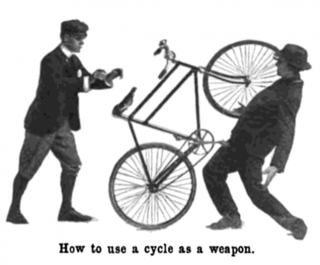
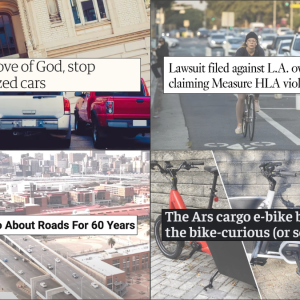
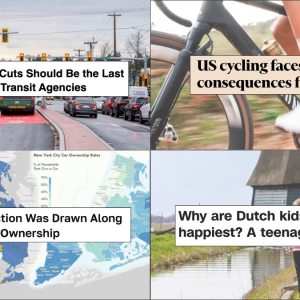
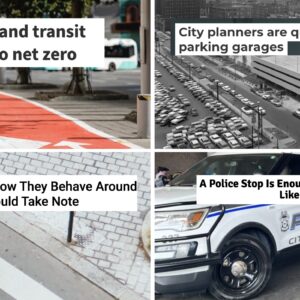
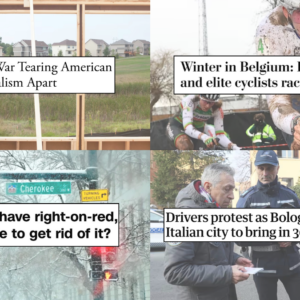
Thanks for reading.
BikePortland has served this community with independent community journalism since 2005. We rely on subscriptions from readers like you to survive. Your financial support is vital in keeping this valuable resource alive and well.
Please subscribe today to strengthen and expand our work.
I think the sentiment reflected in Brian’s article on ITE Trip Generation is more than the whole street fee structure is so screwed up that ITE seems a reasonable starting point.
It’s probably better than using a dart board to determine fees, but just barely. If people thought the ODOT using Strava data was inappropriate, due to skewed samples, applying the ITE data which are collected only in suburbs to businesses in close-in hoods is WAY worse.
Pretty much, yeah, although I intentionally tried to stay away from expressing an opinion on whether it’s a good idea or not to use ITE rates and instead just tried to examine what would need to be considered to do so.
When I wrote that, it looked inevitable that the street fee proposal would try to charge street use as a utility, so you’d have to somehow tease out who’s causing the trips. ITE data, however imperfect, is probably the best starting point. When the new proposal comes out I wouldn’t be surprised if it takes a significantly different form…
Michael, the mugger is in South Africa not Britain. It was reported in the British media, but that is definitely not the UK. The sun doesn’t shine like that over there!
Ha! Quite so. Thanks and fixed.
MADD often seems more opposed to drinking in general than it is to drunk driving. I have actually heard that they have opposed running buses later in some cases because they think it “encourages drinking”.
MADD *is* a neo-temperance/neo-prohibitionist group. The Wikipedia article for that latter term mentions the founder’s split with that group on that issue.
Some would take exception to that label, but “concern” is an effective cover just like “heritage” (for some), “tradition” (of being awful), and “states’ rights” (over civil).
Too bad they’re anti-drinking rather than just anti-driving!;)
A great quote in that article about Tokyo–“social engineering is as important as traffic engineering” or similar. It’s a public policy issue, transportation, as well as a traffic infrastructure issue. The will to regulate road user behavior has to be part of public policy, the will to do the temporarily unpopular. Read the early history of motoring–cars and their users weren’t treated as average Joes and Janes and were not at all liked by the general public. How did they come to dominate our roads?
yeah, that darn rabbi should have been wearing a hi-vis yellow star….
do i get points for being the first to identify godwin?
You win 9000 Internets.
Pretty good Citylabs article on MADD.
My somewhat controversial opinion on MADD and their effectiveness is that their efforts have all been basically a smoke screen. Traffic fatalities involving alcohol have been steadily dropping, but they’ve been dropping at about the same rate as overall traffic fatalities, and the percentage of traffic fatalities involving alcohol has remained relatively steady. That suggests that other factors, not anti-drunk driving campaigning, have led to that drop. Things like safety features in cars, and better road design have been much more effective at lowering fatalities.
MADD is essentially a modernized prohibitionist group, and the drunk driving focus is just a “see drinking is deadly so it is sin” argument.
That’s not to say that drinking and driving is ok, it most certainly is not, that is well proven. It is just that the focus on drinking distracts from the fact that all driving is pretty dangerous and needs to be taken much more seriously. There are a myriad of distractions and other things that may impair you, including just being tired. We should be spending much more of our effort on reducing auto dependence and on engineering safer streets.
History has shown that any attempt to make a high demand activity or substance illegal has the primary affect of creating a criminal infrastructure to profit off of providing it.
<Daria>
We don’t believe in history here in Murica. We don’t ever do anything wrong and have no mistakes to learn from.
</Daria>
Not to say that these things aren’t dangerous but we are as children being told “DON’T TOUCH THAT!”: you’re pretty much guaranteed that a lot of people will.
Daniel, my understanding has been that not only have traffic deaths overall been in decline, but that alcohol as a cause has declined from half of all fatalities to about a third, since MADD started up. I think they do still deserve a lot of credit for what they have done.
But I do share some of the above frustrations with MADD’s emphasis on reducing drinking more than reducing driving. I’ve been legally able to drink since age 19 (and age 18 in a very close neighboring state), and I never supported the MADD/Reagan push to make it 21 nationwide. It’s still my opinion that the 21 policy promotes binge drinking, AND that it actually encourage drunk driving. Better to have a few beers in your dorm than to drive to some off-campus bash where you get even mroe hammered.
And although I’m OK with the lowering of the BAC threshold from .10% to .08%, I think that was a whole lot of effort for very little gain. Drivers between .080% and .099% – those who are impaired but not stinking drunk – aren’t/weren’t the biggest danger. It’s the ones way over .10% that were, and are, doing most of the killing. Where we’d see a bigger benefit is targeting the really drunk drivers, many of whom are regular repeat offenders. The way to reduce those is through better addiction treatment options, follow-up and enforcement of suspended and revoked licenses, mandatory ignition interlocks, etc. etc.
And of course making it easier for drunk people to get around without a car. A lot of people are still going to drink. Many of those who don’t see any other way of getting around by car are still going to drink and drive.
“…That suggests that other factors, not anti-drunk driving campaigning, have led to that drop. …” Daniel L
But in no way, dismisses the irrefutable effectiveness of an advocacy group against drunk drivers, founded by mothers: (‘Mothers’ is what the ‘M’ stands for in case anyone here’ has forgotten.)…of victims of drunk drivers.
So what, the group also feels some opposition to alcohol consumption in general. There’s nothing particularly good about abusing alcohol, whether people are driving, biking or walking. Some of you posting comments here, sound as though the mothers’ opposition to booze abuse makes you feel guilty about whatever your own abuse of the sauce may happen to be.
As you whine on, count your blessing that this advocacy group is making a concerted effort to reduce abuse of alchohol, because there doesn’t seem to be a BADD (bicylists against drunk driving) advocacy group with the kind of clout MADD has to motivate people to oppose alcohol abuse.
Not sure how Alta can demand that those people stop selling the seat by referencing a terms of use agreement that bans people from using attachments. These are two separate issues. The terms of use is a contract with users and I do see how that’s relevant. But someone making those seats stands outside of that agreement.
Re Helmet Wars:
But if I don’t hafta wear a helmet where will I mount my 1800 lumen headlight, GoPro camera, rear view mirror?
Sure it looks “Pee Wee Herman” dorky but how much more ridiculous would it look if I tried to mount all this gear directly to my head?
I’m not making cycling look unsafe, I’m making it look as uncool as your 60 year old cardigan wearing english teacher at a rave.
😉
I really, REALLY hope you’re not using a 1800-lumen head-mounted light on public roads.
JK/LOL
Some people like to bicker endlessly about the merits or lack thereof, of wearing a bike helmet while riding a bike. As if that’s not bad enough, other people, maybe the same ones, apparently love war so much, they cant resist referring to their petty bickering as a ‘war’.
First and foremost, common sense, long before people riding without a bike helmet are actual head wound victims of crashes, is the casualty. The kind of over intellectualizing Jan Heine does in trotting out the tired old arguing points against bike helmet use, may be a culprit in this. At any rate, entire regions of people aren’t buying the points he raises.
Instead, possibly over-reacting, like Vancouver Washington, and King County in the same state have, the implement mandatory all age helmet laws. In part, perhaps because too many people taking a bike out for a ride, may not be relied upon to use common sense that would tell them use of a bike helmet could come in handy if a tumble off the bike crashed their head on the pavement.
The U.S. isn’t any kind of bike nirvana some people claim Europe, Holland or Copenhagen is. Nor does it have much approaching the far more ideal conditions for biking some cities over there have for biking. For someone riding a bike amongst motor vehicles in U.S. traffic, using ‘war-like’ to describe conditions found here, is sometimes not a great stretch. Bicycling in the park or on a MUP may be safe, but riding in traffic here, is dangerous. Easy to get knocked off the bike by a brush with a motor vehicle, or a tire slipping into street car tracks.
I wrote a vaguely funny self-deprecating comment about my personal reasons for wearing a bicycle helmet.
You seem to have interpreted it as a potshot at your deeply held political viewpoints eliciting one of your patented rants.
If anyone ever h@cks your screen name and starts posting as you rest assured at least I will be able to tell the difference.
I will be identifiable by my arcane, persistent and futile attempts at humor.
Good day sir.
Tokyo has a lot of bikers because they don’t subsidize car use like the U.S. Parking, gas taxes, car taxes etc. is very expensive there. In that regard, it’s very instructive.
Given their pre-industrial age urban density it was built out a road network with the capacity to generate a society that is as smitten with automobiles like we are.
At the Velo-City Global Conference a week ago in Adelaide (which I’m surprised hasn’t been picked up amongst your Monday Round-ups) there was a presentation from a Japanese professor commenting on changes happening to sidewalk bicycling in Japan. Interestingly it was only meant to be a temporary measure – 40 years ago! Shared-sidewalk crashes increased by ~50% over the past decade and in recent years, Japan has been looking hard at pushing bikers back onto the roads (or at least to their own separate bikeways). Apparently 90% of their cycle crashes occur at intersections, a lot due to turning motorists not noticing riders on the parallel path. I do worry that if they just shift to painted bike lanes (or in some case “advisory” bike markings) they will see a dramatic drop in bicycle numbers…
That Tokyo article is pretty slanted. The link on bikeportland is hopeful, but somehow the linked article comes across as wrong. Personally or in my opinion.
At some point the cost to society of cleaning up the mess caused by chronically drunk, or just plain BAD, drivers exceeds the cost of just giving every single one of them a free public transit pass for life and a free monthly allotment of taxi rides.
Just
To
Keep
Them
Off
The
Road
That ‘bikes as weapons’ article reminds me of the old Monty Python sketch on self defense. http://youtu.be/4bCyIAsSid8
I have to say, Jan Heine’s piece doesn’t seem to have any remote aspirations of mitigating, let alone ending, the “helmet wars.”
His conclusions strike me more as confirmations of bias in conclusionesque guise.
I was reading Off The Beaten Path’s article on helmets and I was sidetracked by an earlier article about separated bike paths. He couldn’t be more wrong on that point: separated paths (cycle tracks) drastically improve safety.
But let’s just say for the sake of argument that they do not in and by themselves improve safety, and all of the safety improvements that we experience in places like Amsterdam are due to the fact that the large number of cyclists forces drivers to look out for them (this is what the author says). That would still mean that cycle tracks improve safety because it is a certainty that moms with kids in tow, the elderly, and other vulnerable cyclists would not be out on the streets of Amsterdam without the perceived safety provided by cycle tracks. Even according to this extreme argument, cycle tracks drastically improve safety indirectly.
And, by the way, cycle tracks are absolutely essential in and by themselves for safety. Cars and bicycles go at different speeds, and aside from short stretches in residential areas (with regular speed bumps), they do not mix.
Ik heb in Nederland gewoont.
Yes, I personally tend to disagree with Heine on the issue of separated bikeways, for the reasons you mention. Smart dude, though.
“Cars and bicycles go at different speeds”
Sometimes. Even a lot of the time, but less of the time for some than for others. If I can keep up with 12-18 mph traffic in a downtown area, I feel, and actually am, safer than if I were riding in a “protected”, out-of-view cycletrack.
I wonder whether protected cycletracks in and of themselves, without more restricted turning movements for cars, separate signals and signal timing for cars and bikes, more restricted movement for bicycles (esp. RE left turns), laws that encourage and enforce greater responsibility for motorists, and far, far superior driver training actually improve safety. I have a theory that much of the perceived safety improvements afforded by separated cycletracks (minus all the extra accoutrements listed above) are actually the result of more pedestrian behavior by cyclists. If I travel 5-10 mph slower than I otherwise would, slow or stop at every intersection, prepared to yield to unruly drivers “just in case”, and perform two-stage left turns whenever a left turn is needed, I might be just as safe as if I traveled at the speed of traffic in the street, but I would be sacrificing much of my efficiency by doing so. If my 10-minute trip becomes 20 minutes, or worse, my one-hour trip takes an hour and a half, I start to question my mode of transport and might opt for something more time-efficient.
On an unrelated note, will Bike Portland re-visit the PBOT- grant application scandal? The Portland Merc has some strong language re:
the truthfulness of PBOT. Baby Gorilla started something.
I notice that the safer-than-predicted Citi Bikes don’t come with rental helmets. But they do come with wimpy running lights, don’t they?
I agree to an extent with jmassengale’s theory that turn lanes are the cause of drivers believing they should continue unimpeded. My own theory is that right-turn-on-red laws and more recent yield-oriented infrastructure (such as this intersection design: https://goo.gl/maps/RxcQi) have bred generations of drivers not used to coming to a full stop well before turning. People have learned to do a cursory glance for oncoming cars, which puts their trajectory such that the slowest point of their turn is just about centered on any crosswalk (so they can see beyond other stopped cars). I’m absolutely amazed at the number of drivers I can startle by actually being present in a crosswalk on a walk light.